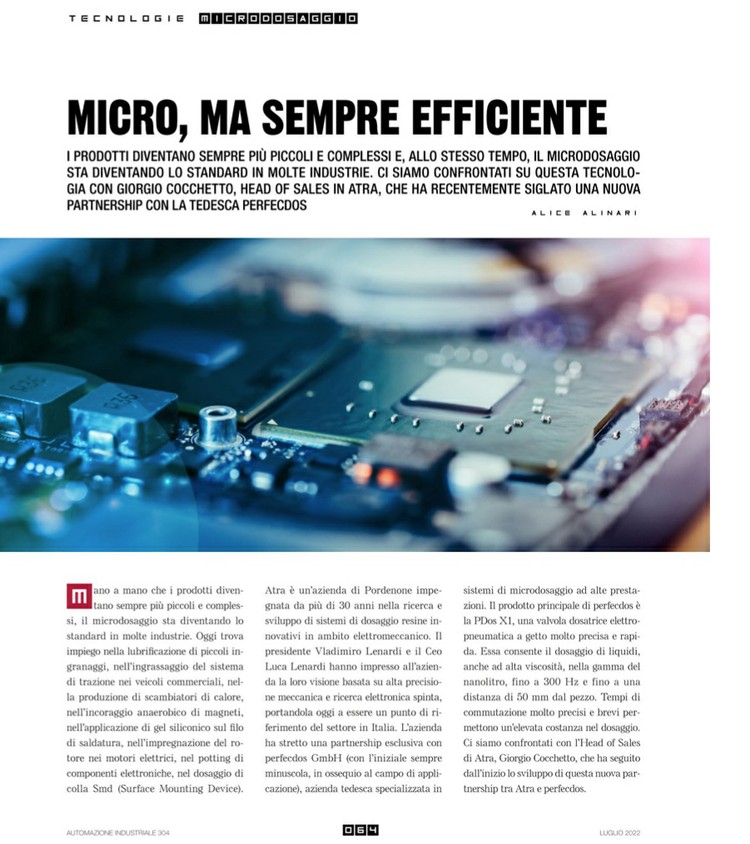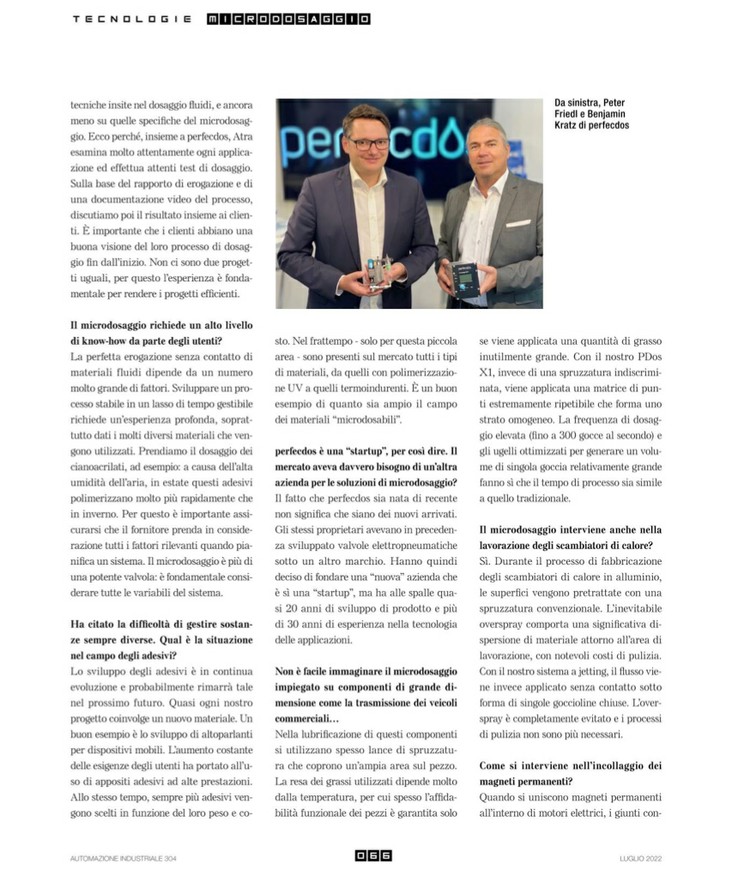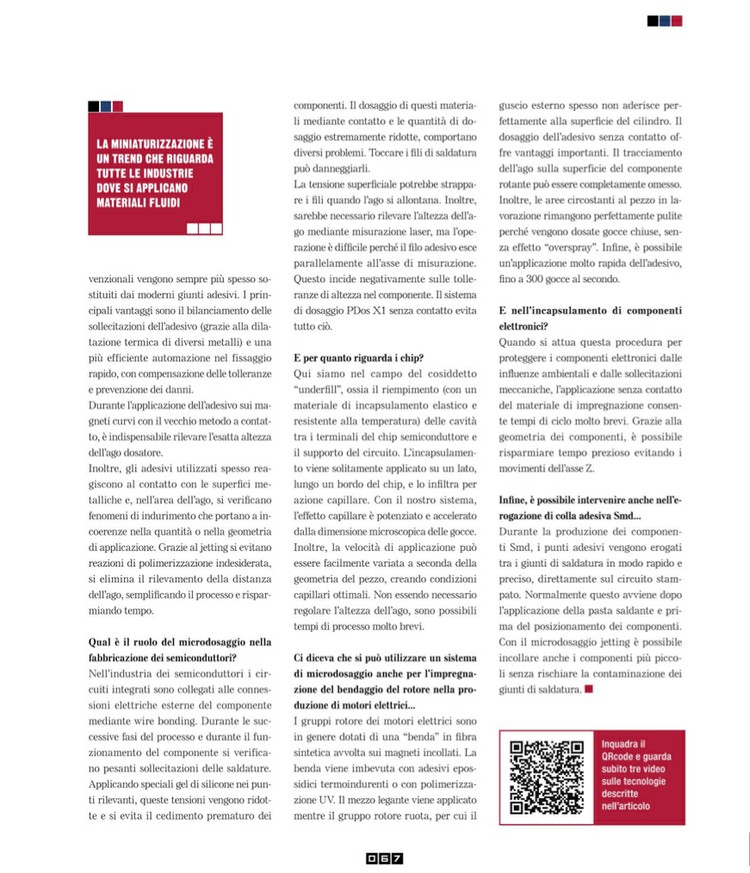As products become smaller and more complex, micro-dosing is becoming the standard in many industries. Today it is used in the lubrication of small gears, greasing of traction system in commercial vehicles, production of heat exchangers, anaerobic magnets bonding, application of silicone gel on the welding wire, rotor impregnation in electric motors, potting of electronic components, dosage of SMD (Surface Mounting Device) glue, and many more.
Atra company has been engaged for more than 30 years in the research and development of innovative resin dosing systems in the electromechanical field. President Vladimiro Lenardi and CEO Luca Lenardi have impressed to the company a vision based on high mechanical precision and strong electronic research, leading it to be the Italian market leader. The company has entered into an exclusive partnership with perfecdos GmbH (with the initial always lowercase, in accordance with the field of application), a German company specializing in high performance micro-dosing systems. The main product of perfecdos is the PDos X1, a very fast and precise electro-pneumatic jet metering valve. It allows the dosing of liquids, even with high viscosity, in the nanoliter range, up to 300 Hz and up to a distance of 50 mm from the piece. Very precise and short switching times allow for high dosage consistency. We met with the Atra Head of Sales, Giorgio Cocchetto, who followed the development of this new partnership between Atra and perfecdos from the beginning.
Everything is getting smaller. How does this affect the dosage?
Remarkably. Over the past five years, the number of systems with droplet sizes of less than 0.5mm has doubled. As the dosing volume decreases, the demands for dosing accuracy increase. For this reason, contactless technology (called "jetting") is increasingly used instead of contact dosing systems. This system eliminates the need to physically bring the valve into contact with the workpiece via axes or robots. This enables extremely short cycle times, a central requirement in automated production. With our system, it is possible to dispense fluids with constant precision on pieces that pass under the valve on a high-speed conveyor belt, without even stopping. Seeing these systems at work is pretty impressive. Given today's industrial requirements, jetting is one of the most efficient systems.
Which industries are driving this development?
The trend towards miniaturization affects all industries where fluid materials are applied, such as adhesives, sealants and lubricants. In addition, companies in the electronics, automotive, pharmaceutical and food industries must comply with increasingly stringent environmental regulations. The precise application of chemical materials allows you to manage plants more efficiently, reduce material waste, protect the environment and save on the costs of disposing of unused material.
Is micro-dosing different from "classic" dosing projects?
Definitely. Since larger quantities of material are dispensed in conventional dosing, tolerances in flow behaviour are not as relevant as in the case of micro-dosing. Here, properties such as viscosity, thixotropy, size and geometry of the dots are decisive, as environmental influences are. In jetting, the thinning of the drop due to cutting plays a particularly important role. In order for the "drop cut" to take place correctly, the material must be "shot" at high speed.
Are these differences likely to be underestimated in practice?
Unfortunately. Apart from the specialists, few people have clear ideas about the technical difficulties inherent in dosing fluids, and even less about micro-dosing. That is why, together with perfecdos, Atra examines each application very carefully and carries out special dosage tests. On the basis of the test report and a video documentation of the process, we discuss the result together with the customers. It is important that customers have a good overview of their dosing process right from the start. No two projects are alike, so experience is essential to make projects efficient.
Does micro-dosing require a high level of know-how from users?
The perfect non-contact dispensing of fluid materials depends on a very large number of factors. Developing a stable process in a manageable time frame requires profound experience, especially given the many different materials that are used. Let's take the dosage of cyanoacrylates, for example: due to the high humidity of the air, these adhesives polymerize much faster in summer than in winter. This is why it is important to ensure that the supplier takes into account all relevant factors when planning a system. Micro-dosing is more than a powerful valve: it is essential to consider all the variables of the system.
You mentioned the difficulty of managing so many different substances. What is the situation in the field of adhesives?
The development of adhesives is constantly evolving and will likely remain so for the foreseeable future. Almost every project of ours involves a new material. A good example is the development of speakers for mobile devices. The constant increase in user needs has led to the use of special high-performance adhesives. At the same time, more and more adhesives are chosen on their weight and cost. In the meantime - only for this small area - all types of materials are on the market, from UV curing to thermosetting ones. It is a good example of how broad the field of “micro-dosable” materials are.
Did the market really need another company for micro-dosing solutions?
The fact that perfecdos was born recently doesn't mean they are newcomers. The same owners had previously developed electro-pneumatic valves under another brand. They therefore decided to found a “new” company that is something like a “startup” with almost 20 years of product development and more than 30 years of experience in application technology behind it.
It is not easy to imagine the micro-dosing used on large components such as the transmission of commercial vehicles.
In the lubrication of these components, spray lances are often used that cover a large area on the piece. The yield of the fats used depends very much on the temperature, so often the functionality of the parts is only guaranteed if an unnecessarily large amount of grease is applied. With our PDos X1, instead of indiscriminate spraying, an extremely repeatable dots matrix is applied which forms a homogeneous layer. The high dosing frequency (up to 300 drops per second) and the optimized nozzles to generate a relatively large single drop volume mean that the process time is similar to the traditional one.
How is micro-dosing also involved in the processing of heat exchangers?
During the manufacturing process of aluminium heat exchangers, the surfaces are pre-treated with conventional spraying. The inevitable overspray involves a significant dispersion of material around the processing area, with considerable cleaning costs. With our jetting system, the flow is applied contactless in the form of single closed droplets. Over-spray is completely avoided and cleaning processes are no longer necessary.
How do you work on bonding permanent magnets?
When joining permanent magnets within electric motors, conventional joints are increasingly being replaced by modern adhesive joints. The main advantages are the balancing of the adhesive stress (thanks to the thermal expansion of different metals) and more efficient automation in quick fixing, with tolerance compensation and damage prevention. During the application of the adhesive on the curved magnets with the old contact method, it is essential to detect the exact height of the dosing needle. In addition, the adhesives used often react upon contact with metal surfaces and, in the needle area, hardening phenomena occur which lead to inconsistencies in the quantity or geometry of application. Thanks to jetting, unwanted polymerization reactions are avoided and needle distance detection is eliminated, simplifying the process and saving time.
What is the role of micro-dosing in semiconductor fabrication?
In the semiconductor industry, integrated circuits are connected to the external electrical connections of the component by wire bonding. During the subsequent steps of the process and during the operation of the component, heavy stress on the welds occur. By applying special silicone gels at relevant points, these tensions are reduced and premature failure of the components is avoided. The dosing process of these materials by contact and the extremely small dosing quantities pose several problems. Touching the solder wires can damage them. The surface tension could tear the threads when the needle moves away. In addition, it would be necessary to detect the height of the needle by laser measurement, but the operation is difficult because the adhesive thread comes out parallel to the measurement axis. This negatively affects the height tolerances in the component. The contactless PDos X1 dosing system avoids this.
And what about the chips?
Here we are in the field of the so-called “underfill”, i.e. the filling (with an elastic and temperature-resistant encapsulation material) of the cavities between the terminals of the semiconductor chip and the support of the circuit. The encapsulation is usually applied on one side, along one edge of the chip, and infiltrates it by capillary action. With our system, the capillary effect is enhanced and accelerated by the microscopic size of the drops. Furthermore, the application speed can be easily varied according to the geometry of the piece, creating optimal capillary conditions. Since it is not necessary to adjust the height of the needle, very short process times are possible.
You told us that micro-dosing system can also be used for the impregnation of the rotor bandage in the production of electric motors.
The rotor assemblies for electric motors are generally equipped with a synthetic fibre “bandage” wrapped on the glued magnets. The bandage is soaked with thermosetting or UV-cured epoxy adhesives. The bonding medium is applied as the rotor assembly rotates, so the thick outer shell does not adhere perfectly to the cylinder surface. Contactless adhesive dosage offers important advantages. The tracing of the needle on the surface of the rotating component can be completely omitted. Furthermore, the areas surrounding the workpiece remain perfectly clean because closed drops are dosed, without any “overspray” effect. Finally, it is possible a very quick application of the adhesive, up to 300 drops per second.
And in the encapsulation of electronic components?
When implementing this procedure to protect electronic components from environmental influences and mechanical stresses, the contactless application of the impregnation material allows very short cycle times. Thanks to the geometry of the components, it is possible to save precious time by avoiding Z axis movements.
Finally, it is also possible to intervene in the dispensing of SMD adhesive glue.
During the production of SMD components, adhesive dots are dispensed between solder joints quickly and accurately, directly on the printed circuit board. Normally this occurs after the application of the solder paste and before the positioning of the components. With micro-dosing jetting, even the smallest components can be bonded without risking contamination of the solder joints.



